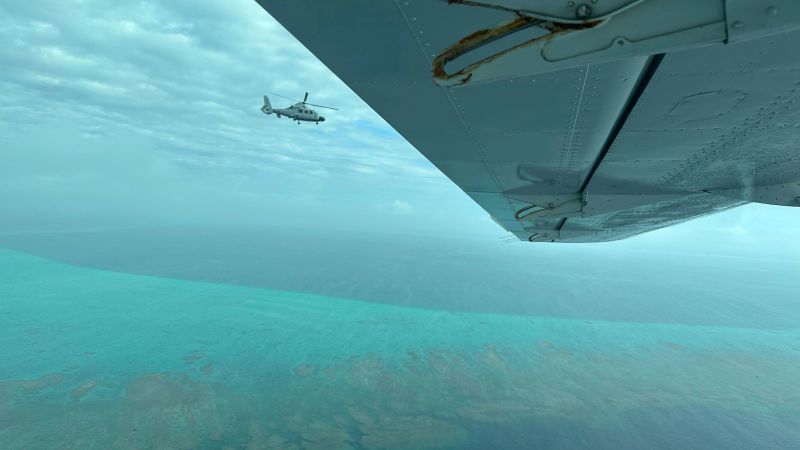
US calls out ‘dangerous’ Chinese helicopter maneuvers as tensions rise over South China Sea
A Chinese military helicopter flew within 10 feet (3 meters) of a Philippine patrol plane over the South China Sea on Tuesday, in what observers said was the second incident of potentially catastrophic behavior by the People’s Liberation Army against foreign aircraft in a week.
Tuesday’s incident was witnessed by an Associated Press reporter aboard the single-engine Cessna Caravan plane operated by the Philippine Bureau of Fisheries and Aquatic Resources as it patrolled near Scarborough Shoal, an uninhabited rock about 140 miles (222 kilometers) west of the main Philippine island of Luzon.
Scarborough Shoal, which sits amid rich fishing grounds, has been effectively controlled by China since 2012 despite its location inside the Philippines’ exclusive economic zone, according to the Asia Maritime Transparency Initiative.
The AP report said during the approximately 30-minute encounter, the pilot of the Philippine plane warned the Chinese helicopter, “You are flying too close, you are very dangerous and endangering the lives of our crew and passengers.”
The ambassador of the United States, a defense treaty ally of Manila, condemned the “dangerous” maneuvers of the Chinese helicopter.
In a post on X, Ambassador MaryKay Carlson also called on China “to refrain from coercive actions and settle its differences peacefully in accordance with international law.”
A statement from the PLA’s Southern Theater Command said the Chinese helicopter “expelled” the Philippine plane from “China’s territorial airspace,” while saying Manila “has seriously violated China’s sovereignty.”
Tuesday’s incident followed another last week over the South China Sea between an Australian military P-8 reconnaissance jet and PLA fighter planes, during which Australia said the Chinese jets fired flares within 100 feet (30 meters) of its aircraft.
If ingested into the P-8’s jet engines, the flares could have caused catastrophic damage, analysts said.
“They could have hit our P-8 and had that occurred it would have done significant damage to our aircraft and that obviously puts in danger the lives of our personnel,” Australian Deputy Prime Minister Richard Marles said on Friday.
Like the latter incident with the Philippines, the Chinese military said it expelled a foreign aircraft that was intruding into Chinese airspace, in this case over the Xisha Islands, also called the Paracel Islands.
Beijing claims “indisputable sovereignty” over almost all of the 1.3-million-square-mile South China Sea, and most of the islands and sandbars within it, including many features that are hundreds of miles from mainland China. As well as the Philippines, Malaysia, Vietnam, Brunei and Taiwan also hold competing claims.
Potentially dangerous incidents between Chinese and foreign aircraft over the South China Sea are nothing new, with several reported over the past several years between not only Australian and Philippine craft but also those of the US and Canada, who all say they operate in international airspace.
But the two latest incidents in less than a week are raising fears Beijing may be becoming more assertive in enforcing its disputed claims while the attention of the US – a defense treaty ally of the Philippines, Australia and Canada – is focused on the war in Ukraine and tensions in the Middle East.
“China sees that the Trump administration is focused on other theaters and calculates that this is the time to turn the ratchet up in East Asia while America is distracted elsewhere,” said Ray Powell, director of SeaLight, a maritime transparency project at Stanford University’s Gordian Knot Center for National Security Innovation.
“Beijing is following a familiar pattern of gradual escalation,” Powell said.
“Its goal is to normalize its aggressions at ever-greater levels, so that over time they become accepted and discounted as the normal cost of doing business in contested areas.”
Adm. Samuel Paparo, the head of the US Indo-Pacific Command, told a forum in Hawaii last week that China is using similar “gray zone” tactics around the democratic island of Taiwan, which is claimed by Beijing, and which Chinese leader Xi Jinping has vowed to bring under the Communist Party’s control.
Numerous Chinese military aircraft and maritime vessels operate around Taiwan daily.
“Their aggressive maneuver around Taiwan right now are not exercises, as they call them. They are rehearsals. They are rehearsals for the forced unification of Taiwan to the mainland,” Paparo told the Honolulu Defense Forum last week.
